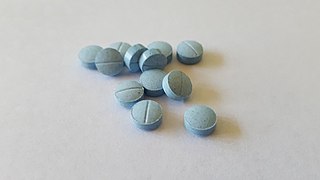
Hypnotic, or soporific drugs, commonly known as sleeping pills, are a class of psychoactive drugs whose primary function is to induce sleep and to treat insomnia (sleeplessness).

Temazepam is a medication of the benzodiazepine class which is generally used to treat severe or debilitating insomnia. It is taken by mouth. Temazepam is rapidly absorbed, and significant hypnotic effects begin in less than 30 minutes and can last for up to eight hours. Many studies, some going as far back as the early 1980s out of Australia and the United Kingdom, both of which have had serious temazepam abuse epidemics and related mortality, have all mostly corroborated each other and proven that the potential for abuse and physical dependence is very high, even in comparison to many other benzodiazepines. As a result, prescriptions for hypnotics such as temazepam have seen a dramatic decrease since 2010, while anxiolytics such as alprazolam (Xanax), clonazepam, and lorazepam (Ativan) have increased or remained stable. Temazepam and similar hypnotics, such as triazolam (Halcion) are generally reserved for severe and debilitating insomnia. They have largely been replaced by z-drugs and atypical antidepressants as first line treatment for insomnia.

Flurazepam is a drug which is a benzodiazepine derivative. It possesses anxiolytic, anticonvulsant, hypnotic, sedative and skeletal muscle relaxant properties. It produces a metabolite with a long half-life, which may stay in the bloodstream for days. Flurazepam was patented in 1968 and came into medical use the same year. Flurazepam, developed by Roche Pharmaceuticals was one of the first benzo hypnotics to be marketed.

Doxylamine, sold under the brand name Unisom among others, is an antihistamine medication which is used in the treatment of insomnia and allergies. It is also used to treat morning sickness in pregnant women in combination with pyridoxine (vitamin B6). Doxylamine is available over-the-counter, and is used in nighttime cold medicines, such as NyQuil, as well as in pain medications containing acetaminophen and codeine, to help with sleep. The medication is taken by mouth.

Doxepin is a medication belonging to the tricyclic antidepressant (TCA) class of drugs used to treat major depressive disorder, anxiety disorders, chronic hives, and insomnia. For hives it is a less preferred alternative to antihistamines. It has a mild to moderate benefit for sleeping problems. It is used as a cream for itchiness due to atopic dermatitis or lichen simplex chronicus.

Nonbenzodiazepines, sometimes referred to colloquially as Z-drugs, are a class of psychoactive drugs that are benzodiazepine-like in uses, such as for treating insomnia and anxiety.

Ramelteon, sold under the brand name Rozerem among others, is a melatonin agonist medication which is used in the treatment of insomnia. It is indicated specifically for the treatment of insomnia characterized by difficulties with sleep onset. It reduces the time taken to fall asleep, but the degree of clinical benefit is small. The medication is approved for long-term use. Ramelteon is taken by mouth.

SB-649868 is a dual orexin receptor antagonist that was being developed by GlaxoSmithKline as a treatment for insomnia.

Asenapine, sold under the brand name Saphris among others, is an atypical antipsychotic medication used to treat schizophrenia and acute mania associated with bipolar disorder as well as the medium to long-term management of bipolar disorder.
The orexin receptor (also referred to as the hypocretin receptor) is a G-protein-coupled receptor that binds the neuropeptide orexin. There are two variants, OX1 and OX2, each encoded by a different gene (HCRTR1, HCRTR2).

Almorexant, also known by its development code ACT-078573, is an orexin antagonist, acting as a competitive antagonist of the OX1 and OX2 orexin receptors, which was being developed by the pharmaceutical companies Actelion and GSK for the treatment of insomnia. Development of the drug was abandoned in January 2011 due to concerns over the hepatic safety of almorexant after transient increases in liver enzymes were observed in trials.

Suvorexant, sold under the brand name Belsomra, is an orexin antagonist medication which is used in the treatment of insomnia. It is indicated specifically for the treatment of insomnia characterized by difficulties with sleep onset and/or maintenance in adults. Suvorexant helps with falling asleep faster, sleeping longer, being awake less in the middle of the night, and having better quality of sleep. Its effectiveness is modest, and is similar to that of other orexin antagonists, but is lower than that of benzodiazepines and Z-drugs. Suvorexant is taken by mouth.
An orexin receptor antagonist, or orexin antagonist, is a drug that inhibits the effect of orexin by acting as a receptor antagonist of one (selective orexin receptor antagonist or SORA) or both (dual orexin receptor antagonis or DORA) of the orexin receptors, OX1 and OX2. Medical applications include treatment of sleep disorders such as insomnia.

TIK-301 (LY-156735) is an agonist for the melatonin receptors MT1 and MT2 that is under development for the treatment of insomnia and other sleep disorders. Its agonist action on MT1 and MT2 receptors in the suprachiasmatic nucleus in the brain enables its action as a chronobiotic. It is in the same class of melatonin receptor agonists as ramelteon and tasimelteon.

Filorexant (INN, USAN; developmental code name MK-6096) is an orexin antagonist which was under development by Merck for the treatment of insomnia, depression, diabetic neuropathy, and migraine. It is a dual antagonist of the orexin OX1 and OX2 receptors. It has a relatively short elimination half-life of 3 to 6 hours. However, it dissociates slowly from the orexin receptors and may thereby have a longer duration. Possibly in relation to this, filorexant shows next-day somnolence similarly to suvorexant. In phase 2 clinical trials, filorexant was found to be effective in the treatment of insomnia, but was not effective in the treatment of major depressive disorder, painful diabetic neuropathy, or migraine. As of May 2015, filorexant was no longer listed on Merck's online development pipeline and hence development of the drug appears to have been discontinued. Development of filorexant may have been discontinued due to lack of differentiation from suvorexant (which was also developed by Merck).

Seltorexant, also known by its developmental code names MIN-202 and JNJ-42847922, is an orexin antagonist medication which is under development for the treatment of depression and insomnia. It is a selective antagonist of the orexin OX2 receptor (2-SORA). The medication is taken by mouth. As of February 2022, seltorexant is in phase 3 clinical trials for treatment of major depressive disorder (MDD) and phase 2 trials for treatment of insomnia. It was also under investigation for the treatment of sleep apnea, but no recent development has been reported for this indication. Seltorexant is under development by Minerva Neurosciences and Johnson & Johnson's Janssen Pharmaceuticals.

Daridorexant, sold under the brand name Quviviq, is an orexin antagonist medication which is used for the treatment of insomnia. Daridorexant is taken by mouth.

Vornorexant, also known by its developmental code names ORN-0829 and TS-142, is an orexin antagonist medication which is under development for the treatment of insomnia and sleep apnea. It is a dual orexin OX1 and OX2 receptor antagonist (DORA). The medication is taken by mouth. As of June 2021, vornorexant is in phase 2 clinical trials for insomnia and phase 1 trials for sleep apnea. It is under development by Taisho Pharmaceutical.

Melatonin is a dietary supplement and medication as well as naturally occurring hormone. As a hormone, melatonin is released by the pineal gland and is involved in sleep–wake cycles. As a supplement, it is often used for the attempted short-term treatment of disrupted sleep patterns, such as from jet lag or shift work, and is typically taken orally. Evidence of its benefit for this use, however, is not strong. A 2017 review found that sleep onset occurred six minutes faster with use, but found no change in total time asleep.

Somnifacient, also known as sedatives or sleeping pills, is a class of medications that induces sleep. It is mainly used for treatment of insomnia. Examples of somnifacients include benzodiazepines, barbiturates and antihistamines.



















